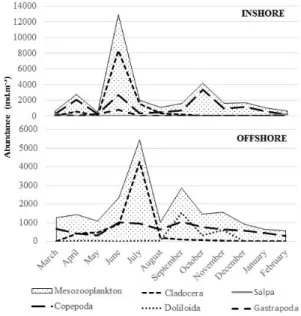THE SUCCESSION OF MESOZOOPLANKTON GROUPS IN INSHORE AND OFFSHORE WATERS OF THE
ISKENDERUN BAY (NORTHEASTERN MEDITERRANEAN SEA)
Tuba Terbiyik Kurt *, Sevim Polat , Gürkan Akbulut and Haluk Yilmaz
Cukurova University, Faculty of Fisheries - tterbiyik@cu.edu.tr
Abstract
The purpose of the present study was to characterize annual cycling of the zooplankton groups and to describe their monthly
succession in the Iskenderun Bay. Zooplankton samples were collected monthly using a WP-2 net (200μm) at inshore and
offshore stations during March 2010- February 2011. A total of 27 mesozooplankton groups were observed. Copepoda mostly
dominated the mesozooplankton population, however the highest abundance peaks were driven by Cladocera during summer
months and by Doliolida in early autumn at offshore. Environmental factors lead to succession of zooplankton groups in the area.
Keywords: Zooplankton , Iskenderun Bay, Copepoda
1 1 1 1
1
Introduction
Iskenderun Bay (avarage depth 70 m) located at the Northeastern corner in the eastern Mediterranean and has a dynamic structure being affected by the local winds, freshwater inputs and current systems prevailing in the eastern Mediterranean. In contrast to ultraoligotrophic trophic structure of Levantine Basin, primary production was 2-4 times higher (Yilmaz et al. 1992) in the bay. Additionally, Iskenderun Bay is regarded intensely industrialized with petroleum pipelines, iron-steel and fertilizer industries and this industrialization is increasing day by day. The aim of this study was to investigate annual succession of most important mesozooplankton groups in the study area and response to main environmental variables. Materyal and Methods
Sampling was performed using WP-2 net (200 μm) at monthly interval at two stations located inshore and offhore region of the Iskenderun Bay. After collection, zooplankton samples were immediately fixed in 4% buffered formalin- seawater solution. The aliquots were obtained with a Folsom splitter, depending on the density of the organisms. The subsamples were identified and counted using a Bogorov counting chamber. Additionally environmental variable (temperature, salinity, chlorophll-a, pikoplankton, phytoplankton and microzooplankton densities) measured at the same time was obtained from Polat (2011). Spearman correlation was applied to test effect of environmental factors on zooplankton groups.
Results
A total of 27 mesozooplankton groups were found in the present study area and all groups were observed in offshore stations, whereas only twenty groups were present in inshore station. Annual mean mesozooplankton abundance was lower at offhore station (1715± 1346 ind. m ) than inshore station (2556±3426 ind. m ). Mesozooplankton abundance fluctuated from 522 to 12931 ind. m inshore station, while from 521 to 5443 ind. m at offshore station. Two zooplankton peaks were observed in the sampling area. Cladocera dominated peaks was clearly observed during June and July in inshore and offshore stations, respectively. Other peak was slightly occured during October and September at inshore and offshore stations, respectively . Copepoda consisted the bulk of the zooplankton population in the most of the year. However, there is clear changes in the dominancy of zooplankton groups at different period. In coastal station, Copepoda dominancy replaced by Salpidae in February and March, Gastropoda in May and Cladocera in June and July (Figure 2). Similarly, Copepoda was mainly dominant in the offshore station. However, Cladocera dominated the zooplankton during May and July, while Doliolida was most abundant group in September (Figure 2). Other important mesozooplankton groups besides dominant groups were Appendicularia, Bivalvia Cirripedia, in inshore station, while Salpa, Appendicularia Chaetognatha, Bivalvia in offshore station. Temperature was most important abiotic factor and well correlated with most of the common zooplankton groups. Especially picoplankton density and temperature is closely related to the Cladoceran peaks. Moreover, Appendicularia was well correlated with Chl-a and, Gastropoda, Cirripedia and Doliolida with phytoplankton density. Zooplankton group composition and abundance changes showed similar trend with previous studies conducted in Iskenderun Bay (Terbiyik Kurt and Polat, 2013; 2014; 2015) As a conclusion, variations in monthly
-3 -3
-3 -3
succession and hence, mainly temperature and food sources play a key role in the structure of zooplankton communities.
Fig. 1. Monthly changes in the dominant mesozooplankton groups.
References
1 - Polat. S., Terbiyik, T. and Mavruk, S., 2011. the Study of the Temporal Changes in Phytoplankton and Zooplankton Communities in Iskenderun Bay, C.U.BAP Project report. 19 p.
2 - Terbiyik Kurt, T. and Polat, S., 2013. Seasonal Distribution of Coastal Mesozooplankton Community in Relation to the Environmental Factors in Iskenderun Bay (Northeast Levantine, Mediterranean Sea), Journal of the Marine Biological Association of the United Kingdom, 93(5):1163-1174. 3 - Terbiyik Kurt, T. and Polat, S., 2014. Characterization of the seasonal and interannual changes in abundance of marine cladoceran species in Turkish coast of the Northeastern Levantine Basin Crustaceana, 87(7):769-783.
4 - Terbiyik Kurt, T. and Polat, S., 2015. Zooplankton abundance, biomass and size structure in the coastal waters of northeastern Mediterranean Sea, Turkish Journal of Zoology, 39: 378-387.
5 - Yilmaz, A., Basturk, O., Saydam, C., Ediger, D., Yilmaz, K. and Hatipoglu, E., 1992. Eutrophication in Iskenderun Bay, northeastern Mediterranean. Science of Total Environment (Special Issue). In Marine
Coastal Eutrophication, edited by Vollenweider, R.A. Marchetti, R. and
Viviani, R. Amsterdam: Elsevier.
